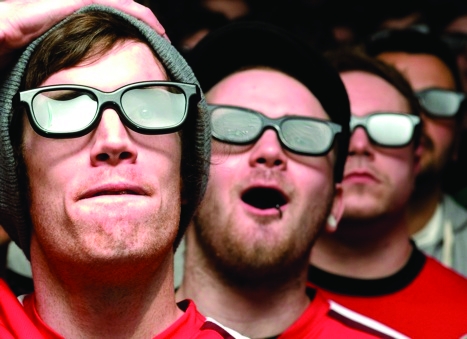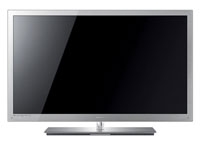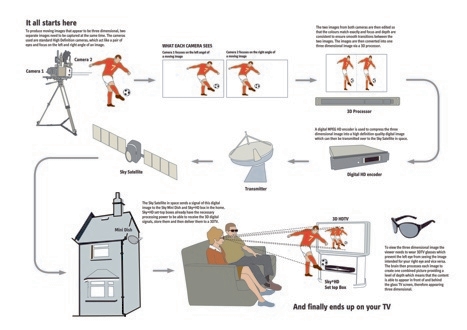Until recently the preserve of selected cinemas - 3D is now poised to make the leap into our living rooms.
The new wave of 3D is well and truly with us, it seems. The science-fiction movie epic Avatar, widely held to be the best example of 3D cinematography yet produced, may have lost out at the Oscars, but it is still lingering at the top of the film charts and praised to the (computer-generated and flocked with floating mountains) skies.
Buoyed up by the acclaim for 3D films, television broadcasters now believe that 3D TV, for so long the province of science fiction itself, is the coming thing in home entertainment; indeed, it could be in your home within the next month. Sky will be the first to bring the extra dimension to home TVs in the UK, launching a new premium channel in April. It has already started screening 3D football matches in pubs; overseas, the US channel ESPN is also planning 3D sports broadcasts, starting in June.

And the hardware is already hitting the shops, with Panasonic, Samsung and Sony all launching 3D-capable high-definition TV sets. Much of this year’s World Cup in South Africa will be shot in 3D.
Avatar took four years in post-production. Such resources aren’t available for TV broadcasting
In itself, 3D imaging is nothing new. The first 3D film was shot in 1922, and the format has had regular revivals, notably in the early 1950s and the late 1970s, and generally centred around thrillers and horror films. Generations of film-goers have been momentarily shocked and, more frequently, slightly puzzled by fuzzy renditions of rocks, cars and giant sharks appearing to shoot out of cinema screens, while struggling to keep floppy cardboard glasses with red and blue lenses on their noses.
These waves of films - and previous attempts at 3D-television broadcasting - used what’s known as the anaglyph method of imaging. The picture consisted of two slightly offset images, one tinted red, the other cyan, and the tinted lenses of the glasses filtered the images so that each eye could only see one. This gave the illusion of depth, allowing the film-maker to ’position’ images in front of and behind the screen.
The latest wave of 3D, proving to be the most successful in the format’s history, uses a slightly different technique. Rather than being tinted, the two images are polarised, with the left and right offset images beamed in perfect synchronicity from two projectors with the polarisation planes set at right-angles to each other. The viewing glasses have polarised lenses with the polarisation planes set at the correct orientation to filter the images, so again, each eye only sees one; but with no tinting, sharper images and a more realistic effect.
The investment required for cinemas to buy in the polarised double-projectors and special screens needed for 3D has been significant, but demand has justified it; and the film studios are continuing to produce content, with Disney films as well as sci-fi thrillers now routinely released in 3D versions.
Bringing 3D into the home will still require viewing glasses, but two different techniques are being employed to create the image and to make sense of them for viewing. One, known as passive viewing, uses polarised images and glasses similar to the cinema experience; the other method, known as active viewing, is currently more common, and has been adopted by Sony, Panasonic, Samsung and Toshiba.
Active viewing uses ’shutter glasses’, whose lenses are effectively LCD screens; transparent when an electric current is passed through them and opaque when no current flows.

The TV transmits alternate pictures, one for the left eye, one for the right, and the glasses - synchronised via an infrared signal transmitted by the television - block out each lens in turn so the viewer can only see the appropriate image in each eye.
The key to this, as with cinema images, is that the alternate pictures are transmitted so fast that the illusion of motion occurs, and the brain isn’t aware that each eye is blocked out for a fraction of a second. However, it presents a consumer problem - every viewer needs glasses, and active-shutter glasses are likely to cost more than £100 for each extra set. Comfort is also an issue; many viewers find 3D viewing a strain, and some cannot see the effect at all.
But for the television manufacturers, the advantage of active viewing is that little new technology is needed in their displays; the filter systems needed to transmit polarised images are more complex and expensive. All that’s needed for active sets in addition to now-standard high definition is the synchronisation system for the glasses and the appropriate image refresh rate.

Sky’s broadcasting will be available in both active and passive formats which, according to BSkyB’s head of product design and innovation, Brian Lenz, will allow consumers a choice of which format to go for; in general, its pub clients, showing 3D football matches, use passive systems, while the home market is more likely to be active. But for the broadcasters, one of the biggest technology problems will come when 3D breaks out of subscriber broadcasting.
’Sky is using a dedicated channel for 3D, and they can do that because it’s a subscription-only service,’ explained Mike Brooks, who heads up technical developments for terrestrial broadcasting at Arqiva, which provides broadcasting infrastructure in Europe and the US. ’They can be certain that everybody receiving their broadcast has the appropriate equipment to view it; the sets, the glasses, the decoder boxes. But terrestrial broadcasters are looking carefully at 3D as well, and for them, the situation isn’t quite as clear.’
A 3D broadcast is unwatchable without glasses, which could mean a major problem. ’Let’s imagine that ITV buys the rights to screen Avatar in a couple of years, and they want to show it over Christmas,’ Brooks said. ’They’re going to want to show it in 3D, of course, but 3D sets are still going to be expensive, and the vast majority of people aren’t going to have them. Are they going to have to choose to show it in 3D and make a three-hour chunk of their schedule unwatchable to most of their audience, or show it in conventional 2D and deprive those viewers who have spent money on 3D-ready [televisions] the chance to see it as it was supposed to be seen?’
Broadcasters are already looking at other ways to use 3D. The BBC has done test filmings of concerts, and Sky is looking at opera, theatre and ballet as part of its Sky Arts programming, as well as the big-ticket sports portfolio it holds with its exclusive football and cricket rights.
“Platform selectivity is going to be the most logical way to transmit 3D”
MIKE BROOKS, ARQIVA
The likely outcome, Brooks believes, is that broadcasters will choose a signal that a standard TV will interpret as 2D, and a properly equipped set will interpret as 3D. ’Think about the way colour was introduced, in the late 1960s and early 1970s,’ he said. ’Not many programmes were being broadcast in colour, early on - it was Wimbledon and the FA Cup final. So if you had a black-and-white set, you’d just be able to see those programmes in black and white with no problems; if you were lucky enough to have colour, they’d appear in colour. That model is known as platform selectivity, and it’s going to be the most logical way to transmit 3D.’
There is an alternative offered by digital TV - the ’red button’ optional content. ’But broadcasters are going to be reluctant to use that, because it means tying up extra bandwidth unnecessarily.’
It will be an expensive proposition to buy a 3D set, and Lenz admits that take-up is likely to be slow; people are now buying high-definition sets, and the initial 3D offerings will cost around £2,000 for a large-screen system. But unlike the early days of colour, there are now additional drivers for television content. You don’t have to rely on just broadcasters anymore.
There’s now packaged media - the DVD and Blu-Ray markets, all of whom want to be able to release 3D versions of current hits. Blu-Ray 3D disks will be platform selective, showing a 2D version automatically on conventional 2D equipment and switching to 3D when available.

There’s also computer gaming, which many in the industry believe will be hugely important. ’It’s undoubtedly going to be a major driver into getting 3D receivers into homes,’ Brooks said. Avatar is again leading the way, with early views of the 3D game based on the film delivering a similar ’wow’ factor. However, some industry observers have pointed out that a major rethink in how games are designed might be necessary, and that 3D gaming actually goes counter to the way that designers are currently working on their creations.
’The current crop of video games use very kinetic camerawork to make them immersive,’ explained Simon Munk, who writes on video gaming and consumer electronics for UK newspapers and magazines. ’For one thing, that’s very expensive in terms of processing power; rendering them in 3D is going to be even more expensive. Just as important, watching something like that in 3D with the level of concentration you need for gaming is likely to make you feel nauseous.’ Video-game producers are now more concerned with involving the player through storytelling and challenging their intelligence, in order to reach untapped markets of older and female consumers, he added.
It’s undeniable that 3D is coming, and that the TV sets on sale within five years will include it as standard. But how fast it comes in, and how and what we’ll be watching, is still in question - and not just for the programmers.
in depth rolling costs
In Depth
Rolling Costs
TV broadcasters will require 3D filming equipment to fall within smaller-scale budgets
Watching 3D television isn’t just a matter of transmission; the equipment needed to film in 3D is also developing.
The Fraunhofer Institutes in Germany have been busily working on these problems, which largely centre around reducing the cost and complexity of 3D production. Working on Avatar, for example, director James Cameron took so much time that the film almost became an urban myth; it cost much more than $250m (£166m) and took four years in post-production alone. Such resources, both of time and money, aren’t available for TV broadcasting, especially with 3D’s heavy initial reliance on the sports market, where live broadcasting is so important.
The Fraunhofer team, from the institutes for integrated circuits in Erlangen and for telecommunications in Berlin, have developed a 3D camera system that works with an image-analysis unit to process 3D images in real time. The system uses two camera, fixed in position to simulate the position of human eyes and closely synchronised to ensure that the 3D illusion is true to life.
The cameras are linked electronically to ensure that the images from each are compatible; one camera acts as the ’master’, and the other performs settings for calibration, colour and geometry. ’The most infinitesimal shift or tilt of the camera becomes visible on-screen, and can even make you nauseous,’ said Stephan Gick, group manager for digital camera systems at the Institute for Telecommunications.
Post-processing has to tackle the streams from each camera in synch, and for this, Gick’s team worked with KUK Filmproduktion to develop a stereoscopic analyser system known as STAN. This constantly checks the images, and uses a feedback loop to check and recalibrate the camera setting in real time.
Back Story
Birth of a Station
In June 1926, The Engineer got its first glimpse into the world of television
A few days ago we had an opportunity of being present at a demonstration given at the offices of Television Ltd, in Upper St Martins Lane, when the face of a person in the upper part of the building was made to appear on the screen of the receiving apparatus in the basement.
Instructions to move the head, open the mouth and so on were sent form the receiver to the transmitter by telephone, and every moment was duly reproduced on the screen.
True, the results left a good deal to be desired, for they did not in any way compare with those of the modern cinematograph, but they served to demonstrate that television has been made possible, and that in all probability infinitely better results will be secured in the near future.’




April 1886: the Brunkebergs tunnel
First ever example of a ground source heat pump?